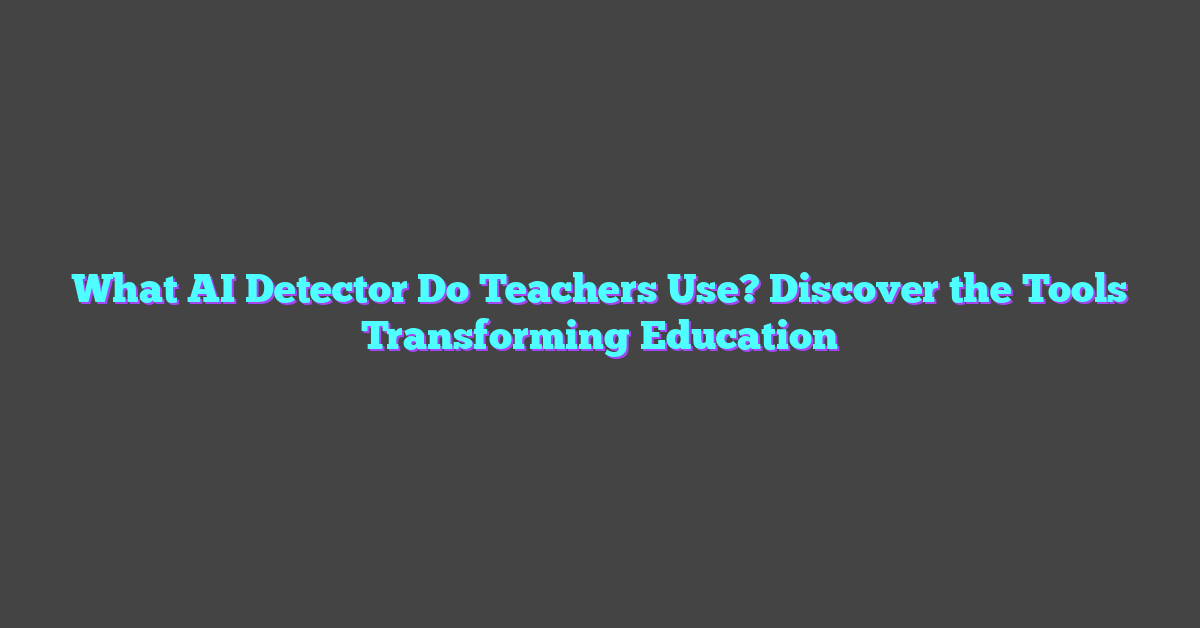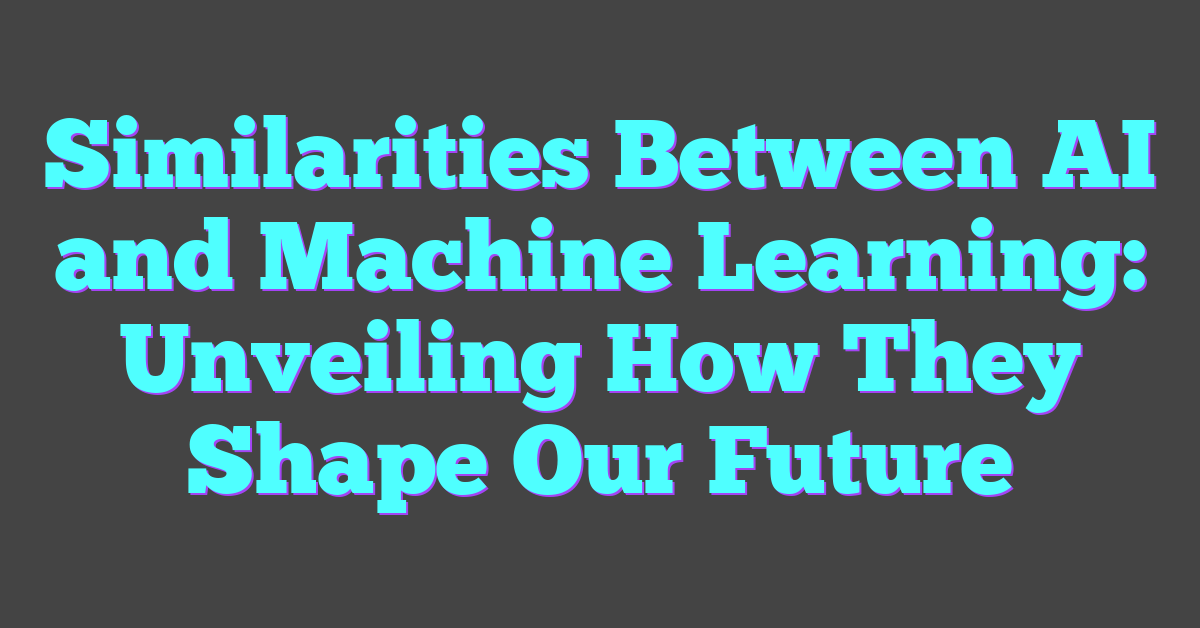In the digital age, teachers are increasingly turning to AI detectors to help maintain academic integrity. It’s a tech-savvy solution to a modern problem: how to spot the subtle signs of AI-generated work among students’ submissions.
They’re on the lookout for tools that not only catch the cheats but also support honest students in their learning journey. This article dives into the AI detectors that educators are using, exploring how these digital detectives are reshaping the landscape of learning and assessment.
So, if you’re curious about the virtual sidekicks that teachers are employing to uphold originality in the classroom, stay tuned. You’re about to get a peek into the world of AI detection that’s becoming an essential part of the educational toolkit.
How AI Detectors Are Changing the Way Teachers Maintain Academic Integrity
Teachers are harnessing the power of AI detectors to redefine the boundaries of academic honesty. By using sophisticated algorithms, these tools scrutinize students’ work for signs of AI-generated content, leaving no place for dishonesty to hide.
One of the most significant changes is the shift in focus from punishment to prevention. AI detectors are not just tools for after-the-fact detection; they serve as a deterrent, discouraging students from resorting to AI-assisted cheating in the first place. Students know their work will be analyzed by these cutting-edge systems, creating a genuine incentive to maintain integrity in their academic endeavors.
The integration of AI detectors into the educational process has streamlined the assessment workload of teachers. Rather than spending countless hours reviewing assignments manually, educators can rely on AI to flag potential issues. This affords them more time to invest in teaching and one-on-one interactions with students, which can foster a deeper understanding and commitment to original work.
Furthermore, AI detectors are evolving to offer more than just detection services. Advanced feedback mechanisms are being integrated into these platforms, helping students understand why and how their work might be flagged as problematic. This educative approach not only catches inadvertent lapses but also enlightens students on the nuances of academic integrity, enabling them to learn from their mistakes.
- Benefits of AI Detectors in Education:
- Deter AI-assisted cheating
- Elevate educational process efficiency
- Provide formative feedback to students
With AI detectors becoming more prominent in academia, there’s a growing appreciation for the delicate balance between technological advancement and ethical standards. These systems are continually updated to keep up with evolving AI writing tools, ensuring that they remain an effective component in the pursuit of academic integrity. They’re becoming an essential part of an educator’s toolkit, signaling a new era where technology and human oversight unite to uphold the core values of education.
The Problem: Identifying AI-Generated Work Among Student Submissions
In the realm of academics, teachers face a significant challenge: the rising tide of AI-generated work submitted by students. While AI tools can bolster a student’s learning experience, they’ve also opened a door to new forms of academic dishonesty. The crux of the problem rests in distinguishing between genuinely student-produced content and that which is crafted by sophisticated language processing algorithms.
Detecting AI-generated text is a nuanced task that even experts in AI and machine learning find complex. The linguistic patterns AI models use can be incredibly human-like, making it difficult for instructors to spot inconsistencies on their own. Traditional methods of assessing students’ work for authenticity, such as looking for out-of-character changes in writing style, are not always foolproof against the backdrop of continually evolving tech.
As such, educators are turning to specialized AI detectors with advanced capabilities designed to parse submissions for telltale signs of machine authorship. These tools often employ algorithms built to recognize subtle quirks specific to AI text generators, such as unusual syntax or patterns that don’t typically occur in human writing. However, it’s important to acknowledge that no tool is perfect and false positives can occur. Teachers must therefore wield these detectors judiciously, as part of a comprehensive strategy to maintain academic integrity.
To better equip themselves, educators are becoming more tech-savvy, often partaking in professional development sessions focusing on digital literacy. They’re learning how AI-generated content operates, which then informs their teaching and how they design assignments to mitigate the temptation for students to use AI inappropriately. Through these efforts, they’re not only enhancing their detective work but also strengthening the preventive structures within academia that uphold the value of original thought and effort.
The Role of AI Detectors in Supporting Honest Students
In the battle to uphold academic integrity, AI detectors have emerged as invaluable allies for honest students. These students put in considerable effort to learn and produce original work, and AI detectors help ensure their diligence is not undermined by others’ shortcuts.
AI detectors level the playing field by making it harder for students to pass off AI-generated content as their own. This reassures students that their efforts are appropriately valued and that academic evaluations are fair. Educators equipped with these tools send a clear signal that honesty is not just expected but actively upheld.
Teachers use detectors, such as Turnitin and Copyscape, which have advanced by integrating algorithms designed to sniff out the ‘non-human’ text patterns that AI often leaves behind. Unlike the human eye, which can miss subtle details, these detectors are relentless in uncovering inconsistencies indicative of AI authorship.
Honest students also benefit from the feedback AI detectors provide. When a student’s submission is flagged, it presents a learning opportunity. Perhaps they’ve inadvertently mirrored the style of an AI generator or a database text, teaching them to be more critical and unique in their thought processes and writing techniques.
The introduction of AI detection software not only prevents dishonesty but also empowers students to uphold their integrity. With knowledge that their institution uses cutting-edge technology to detect AI, students may become more motivated to develop their writing skills, knowing that their human creativity and intellect are irreplaceable by machines.
In classrooms, discussions around the use of AI detectors can spark rich conversations about ethics and responsibility in digital age learning. These conversations engage students and encourage them to think critically about the role of technology in education and how it should be harnessed to support rather than undermine their academic journey.
By integrating AI detectors in the academic process, educators reinforce the value of original thinking and the importance of hard work. In turn, students who abide by these principles find their dedication acknowledged and their academic contributions credited fairly. They become part of an academic culture that celebrates true scholarship and the unique perspectives that only humans can bring to the table.
Exploring the Different AI Detectors Used by Educators
Educators around the globe are turning to a variety of AI detectors to ensure the originality of students’ work. Turnitin, a tool widely recognized in the academic community, is praised for its comprehensive database and robust comparison algorithms. It’s known for its efficacy in detecting plagiarism in written assignments and research papers.
Another player in the field is Grammarly, which has expanded its capabilities to include plagiarism detection alongside its grammar and writing suggestions. Grammarly checks texts against billions of web pages to catch instances of unoriginal content. It’s particularly helpful for students seeking both language enhancement and assurance of content originality.
Copyscape offers simplicity and ease of use, allowing teachers to quickly scan the web for duplicate content. Likewise, Plagscan is a go-to resource thanks to its user-friendly interface and thorough scanning methods. It can analyze a document against various online sources and its internal database.
The use of ProWritingAid is spreading due to its in-depth reports on style and readability besides plagiarism. It provides a holistic view of a student’s writing, flagging elements that signify possible AI-generated content.
AI detection is not only about catching cheats but also about fostering development in writing. Chegg Writing, for instance, combines AI detection with resources to help students understand citation and paraphrasing. This educational approach bolsters student comprehension of academic honesty principles.
In the realm of comprehensive tools, Unicheck emerges as an effective solution for both individual educators and institutions. It stands out with its real-time search technology and integrations with widely-used educational platforms.
| Detector | Main Function | Additional Features |
|---|---|---|
| Turnitin | Plagiarism detection | N/A |
| Grammarly | Grammar and writing improvement | Plagiarism detection, writing enhancement |
| Copyscape | Online plagiarism detection | N/A |
| Plagscan | Text analysis and plagiarism check | User-friendly interface |
| ProWritingAid | Style and readability analysis | Plagiarism check |
| Chegg Writing | Plagiarism detection | Citation and paraphrasing resources |
| Unicheck | Plagiarism detection and prevention | Real-time search, educational platform integration |
How AI Detection is Reshaping the Landscape of Learning and Assessment
The integration of AI detection tools into educational systems is revolutionizing the way learning and assessment are conducted. With the advent of sophisticated algorithms, educators now have unparalleled access to data-driven insights that are transforming traditional pedagogies.
AI detection software has made significant strides in automating the grading process. These tools utilize natural language processing and machine learning to evaluate written assignments, providing immediate feedback on grammar, style, and even content relevance. This automation reduces the grading load on teachers, allowing them more time to focus on personalized instruction and enabling them to handle larger class sizes without compromising the quality of feedback students receive.
In addition to grading, AI is enhancing formative assessments by identifying gaps in student understanding. With adaptive learning technologies, educational platforms can offer personalized learning paths, tailored to individual student needs. As students interact with the content, the AI adjusts the difficulty and topics of subsequent materials, ensuring that each learner is challenged at just the right level to maximize engagement and retention.
The role of AI doesn’t stop at grading and personalized learning. It’s also shaping the future of academic integrity. AI detectors serve a dual purpose: they highlight instances of potential plagiarism, and they’re an educational tool that teaches students about the importance of originality and the proper ways to cite sources. By integrating these tools, institutions are reinforcing the value of honesty while equipping students with the critical skill of producing original work.
Through the analysis of vast arrays of educational data, AI platforms are beginning to predict student performance, potentially identifying at-risk students earlier than ever before. This predictive ability enables educators to intervene promptly, offering support that’s specifically tailored to assist students in overcoming their unique obstacles, thus improving overall educational outcomes.
These advancements brought by AI detectors are evidence of a shift towards a more data-informed educational landscape, where technology plays a crucial role in fostering learning environments that are adaptive, efficient, and integrity-driven. As these tools continue to evolve, they’re set to further refine the nuanced art of teaching, ultimately enriching both the educational experience and the process of knowledge acquisition.
Conclusion
Teachers are embracing AI detectors to create a more dynamic and honest educational atmosphere. They’re not just tools for catching plagiarism; they’re reshaping how educators assess, support, and engage with their students. As these technologies continue to evolve, they promise to further enrich the learning experience, making it more personalized and proactive. The future of education looks brighter as AI helps build environments where every student has the chance to thrive.
Frequently Asked Questions
How are AI detection tools changing education?
AI detection tools are transforming education by automating grading, offering personalized learning, and identifying gaps in student understanding. They reinforce the importance of originality and help predict student performance.
What benefits do AI detectors provide in educational systems?
AI detectors provide benefits such as efficient grading, customized learning paths for students, detection of plagiarism, and early identification of students who may need additional support.
Can AI in education predict student performance?
Yes, AI tools in educational systems can analyze data to predict student performance, which allows teachers to intervene earlier and provide necessary support to at-risk students.
How do AI detection tools help with student assessments?
AI detection tools streamline the assessment process by automating grading, thereby saving time for teachers. They also ensure assessments are objective and consistent.
What role do AI platforms play in addressing academic integrity?
AI platforms play a significant role in upholding academic integrity by teaching students about the importance of originality and proper citation to avoid plagiarism.
Do AI detection tools assist students directly?
Yes, AI detection tools directly assist students by providing immediate feedback, pointing out learning gaps, and creating personalized educational experiences to enhance their understanding and performance.




